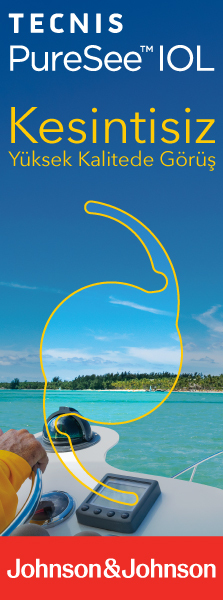2MD, Haseki Training and Research Hospital, Ophthalmology Department, Istanbul, Turkey
3Prof. MD, Haseki Training and Research Hospital, Ophthalmology Department, Istanbul, Turkey DOI : 10.37844/glauc.cat.2021.16.18 Purpose: To evaluate the refractive outcomes and intraocular stability of Acriva toric intraocular lens (T-IOL) (Acriva BB Toric UDM 611, VSY, Istanbul, Turkey) in patients with astigmatism of more than 1.50 diopters (D).
Materials and Methods: In this prospective study, we included twenty-fi ve eyes of 21 cataract patients with corneal astigmatism more than 1.50 D. All patients underwent phacoemulsifi cation surgery with T-IOL implantation and followed up to at least three months. Uncorrected distance visual acuity (UDVA), best-corrected visual acuity (BCVA), intraocular pressure (IOP), refractive parameters (spherical and cylindrical refractive error, spherical equivalent), and IOL axis rotation and were evaluated on the postoperative 1 day, 1 week, 1 month and 3-month visits. The measurements in the 3rd month were accepted as postoperative values. The distance spectacle prescription requirement was recorded.
Results: Twenty-fi ve eyes of 21 patients were included (11 male, 10 female) with the mean age of 59.60±10.50 (48-71) years. Preoperatively, UDVA and BCVA were 0.93±0.41 and 0.55±0.40 logMAR, respectively while postoperative UDVA and BCVA were 0.05±0.034 logMAR and 0.03±0.03 logMAR, respectively. Preoperatively, the mean cylindrical refractive error was 2.66±1.03 D, the spherical equivalent was -2.91±2.00, and mean corneal astigmatism was 1.98±1.04 D. Postoperatively, the mean cylindrical refractive error and spherical equivalent decreased to -0.50±0.25 D and -0.33±0.24 D, respectively. Mean IOL rotation was 2.52±2.35° (0-10°). Six eyes (24 %) needed spectacle, while 19 eyes (76 %) were spectacle-independent for distant vision. None of the patients were required additional surgical intervention to correct postoperative astigmatism until the 3-months follow-up period.
Conclusion: Acriva BB Toric UDM 611 IOL has achieved satisfying refractive results and positional stability in cataract patients who expect a spectacle-independent distance vision with more than 1.50 D astigmatism in the postoperative period.
Keywords : Toric intraocular lens implantation, Astigmatism, Acriva toric intraocular lens, Cataract surgery




